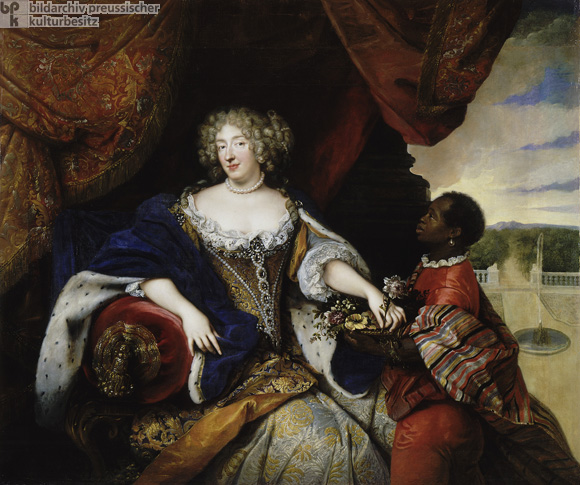|
Charlotte-Elisabeth of Bavaria, Princess of Palatinate, Duchess of Orléans (1680)
Better known in German historiography by her nickname “Liselotte of the Palatinate,” Charlotte-Elisabeth (actually, Elisabeth Charlotte, 1652-1722) was the daughter of the Elector Palatinate Charles I Louis (1617-80). In 1671, at the age of nineteen, she was forced to marry Philipp I of Orléans (1640-1701), the brother of Louis XIV (r. 1661-1715). She moved to the French court against her will and spent half a century living there as a critical observer. Liselotte’s criticisms were directed above all at what she perceived as the excessive opulence of the French nobility. “The ignobility of displays of splendor” [“Unwürdigkeit der Prachtentfaltung”] was a constant theme of her extensive correspondence, which offers an unvarnished glimpse into Europe’s premier royal seat. She had equally strong feelings about the disappearance of status-appropriate [standesgemäß] manners, morals, and customs, citing frivolity and new relaxed forms of dress as evidence thereof. Likewise, she had harsh words for French cuisine and generally rejected the French way of life, remaining true to and proud of her German upbringing, language, and culture. After the death of her brother Charles II (r. 1680-85), Liselotte’s formal title – Princess of Palatinate – gave Louis XIV a pretext to lay claim to the Palatinate. In 1688, he followed through with his expansionist plans and sent French troops into the Palatinate, sparking yet another conflict with the Holy Roman Empire: the War of the League of Augsburg (or Palatinate War), which lasted until 1697. The conflict saw the devastation of Liselotte’s homeland. During its course, Emperor Leopold I (r. 1658-1705) managed to exploit widespread public outrage at the French “scorched earth” policy (which resulted in the leveling of the city of Heidelberg, to name but one example) to form a grand coalition comprised of Britain, Spain, the Netherlands, and Savoy. In the Peace of Ryswick (1697), the grand coalition forced Louis XIV to relinquish his claims to Lorraine and the Palatinate but allowed him to keep the former imperial city of Strasbourg and other Alsatian “reunions.” The portrait below was painted by French artist François de Troy (1645-1730), who worked in French court circles for nearly five decades. In some respects, de Troy was Liselotte’s ideal portraitist, since he was known for his ability to capture the nobility’s preoccupation with manners, status, and dress. Like many of de Troy’s female subjects, Liselotte is dressed in rich, traditional garb – the “grand robe” that she so favored – and is accompanied by an elaborately dressed servant. A section of the royal gardens at Versailles can be seen in the background.

|


